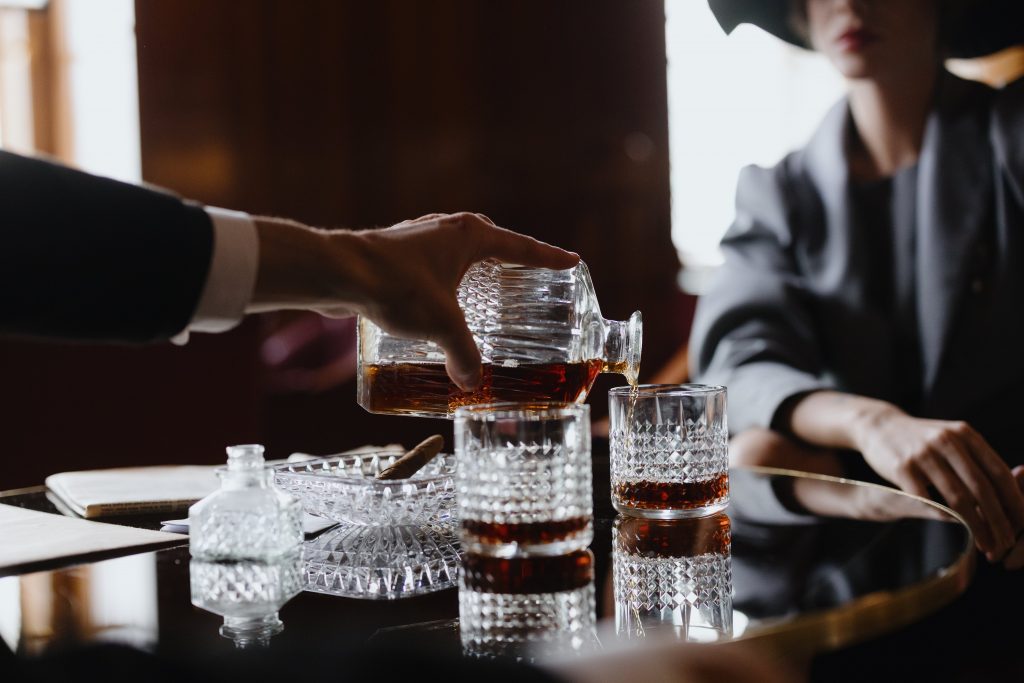Discover The Art of Whisky Tasting
Fully Appreciate Premium Whisky
Before starting the tasting process, it’s important to understand what makes whisky special. Whisky is an alcoholic drink distilled from fermented grain mash, which can include barley, corn, rye, and wheat. The variety of grains and the aging in wooden casks contribute to the wide range of flavors in whisky.
The Tasting Process
Tasting whisky is an art that engages all your senses, not just your taste buds. Here’s a step-by-step guide to mastering it:
- Choosing the Right Glass
- The glass you select can greatly influence your tasting experience. A tulip-shaped or Glencairn glass is ideal, as it focuses the aromas at the top, helping you fully appreciate the whisky’s nose.
- Observing the Appearance
- Hold your glass up to the light and observe the whisky’s color, which can range from pale gold to deep amber. The color often hints at the type of cask used for aging and the maturation length.
- Nosing the Whisky
- Gently swirl the whisky in the glass to release its aromas. Bring the glass to your nose and inhale deeply, identifying different scents such as fruity, floral, spicy, or smoky notes. This step is crucial because much of what we perceive as taste comes from our sense of smell.
- Tasting the Whisky
- Take a small sip and let it roll over your tongue. Pay attention to the flavors that develop—is it sweet like honey or caramel? Does it have a hint of spice or smoke? Notice the texture—is it smooth, oily, or dry?
- Assessing the Finish
- The finish refers to the aftertaste left on your palate after swallowing. A long finish often indicates higher-quality whiskies, with complex flavors that evolve over time.
Enhancing Your Tasting Experience
- Add Water: Adding a few drops of water can open up the whisky’s flavors by reducing the alcohol’s intensity, allowing subtler notes to emerge.
- Use a Clean Palate: Avoid strong foods or drinks before tasting to ensure your palate is clean and receptive.
- Compare Different Whiskies: Tasting several whiskies side by side can highlight their unique characteristics.
Appreciating the Craftsmanship
Premium whisky is a testament to meticulous craftsmanship and tradition. From selecting quality grains to aging in carefully chosen casks, each production step influences the final product. Understanding this journey can deepen your appreciation for the complexity found in every glass.
The Role of Terroir
Like wine, whisky’s flavor can be influenced by terroir—the climate, soil, and geography where it’s produced. Scottish whiskies, for instance, often reflect their coastal origins with briny notes.
Master Blenders and Distillers
A team of skilled blenders and distillers stands behind every premium whisky, dedicated to perfecting their craft. Their expertise ensures consistency and quality while exploring new flavor profiles.
Pairing Whisky with Food
Pairing whisky with food can enhance both the drink and the dish. Here are some pairing suggestions:
- Chocolate: Dark chocolate complements sweeter whiskies like bourbon.
- Cheese: Aged cheeses pair well with robust Scotch.
- Grilled Meats: Smoky whiskies enhance the flavors of grilled or barbecued meats.
The Cultural Significance of Whisky
Whisky is more than just a beverage; it plays an integral role in cultural traditions worldwide. In Scotland, whisky is intertwined with celebrations like Burns Night, while in Japan, it’s enjoyed as part of a refined dining experience.
The art of tasting whisky is a rewarding exploration into flavor, history, and craftsmanship. By following these steps and taking time to appreciate each facet of your whisky, you’ll gain a deeper understanding and enjoyment of this remarkable spirit. Whether sharing a dram with friends or enjoying a quiet evening alone, remember that every glass holds a story waiting to be discovered.
